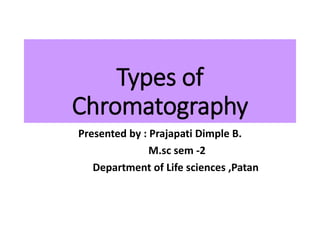
Types of chromatography
- 1. Types of Chromatography Presented by : Prajapati Dimple B. M.sc sem -2 Department of Life sciences ,Patan
- 2. Content Types of Chromatography Paper Chromatography Gas chromatography Thin layer Chromatography High performance thin layer Chromatography
- 3. What is Paper Chromatography? Paper Chromatography is an analytical method used to separate colored chemicals or substances.
- 4. Principle of Paper Chromatography The principle involved is partition Chromatography wherein the substances are distributed or partitioned between liquid phases. One phase is the water , which is held in the pores of the filter paper used ; and other is the Mobile phase which moves over the paper.
- 6. Application of Paper Chromatography Paper Chromatography is specially used for the separation of a mixture having polar and non polar compounds. For separation of amino acids. It is used to determine organic compounds , biochemicals in urine etc. In the pharma sector it is used for the determination of hormones ,drugs etc. Sometimes it is used for evaluation of inorganic compounds like salts and complex.
- 7. What is gas chromatography? Gas chromatography (GC) is a common type of Chromatography used in analytical chemistry for separating and analyzing compounds that can be vaporized without decomposition. In gas chromatography , the Mobile phase ( or '' moving phase'') is a carrier gas , usually an inert gas such as helium or an unreactive gas such as nitrogen . The stationary phase is microscopic layer of liquid or polymer on an inert solid support , inside a piece of glass or metal tubing called a column.
- 8. Principle of gas chromatography The sample solution injected into the instrument enteres a gas stream which transport the sample into a separation tube known as the " column" ( Helium or nitrogen is used as the so called carrier gas) . The various components are separated inside the column.
- 10. Application of gas chromatography Gas chromatography ( GC) is an instrumental technique used forensically in drug analysis ,arson , toxicology analyses of other organic compounds. Gas chromatography is a physical separation method in where volatile mixtures are separated.
- 11. What is TLC ? Chromatography in which compounds are separated on a thin layer of absorbent material , typically a coating of silica gel on a glass plate or plastic sheet. Thin layer of absorbent is known as the stationary phase . After the sample has been applied on the plate , a solvent or solvent mixture ( known as the Mobile phase) is drawn up the plate via capillary action.
- 12. Principle of TLC TLC works on the same Principles. In thin layer Chromatography , the stationary phase is a polar absorbent , usually finely ground alumina or silica particles. This absorbent is coated on a glass slide or plastic sheet creating a thin layer of the particular stationary phase.
- 14. Application of TLC Purity of sample: • Purity of sample can be carried out with TLC. Identification of compounds : • Thin layer Chromatography can be employed in purification , isolation and identification of natural products like volatile oil or essential oil, fixed oil, waxes, terpenes ,alkaloids ,glycosides,steroid etc. Examination of reaction
- 15. What is HPTLC? High performance thin layer Chromatography (HPTLC) is an enhanced form of thin layer Chromatography (TLC). A number of enhancement can be made to the basic method of thin layer Chromatography to automate the different steps, to increase the resolution achieved and to follow more accurate quantitative measurements.
- 16. Principle of HPTLC HPTLC have similar approach and employ the same physical principles of TLC ( adsorption Chromatography ) i.e., the principle of separation adsorption. The Mobile phase solvent flows through because of capillary action .the components move according to their affinities towards the absorbent . The components with more affinity towards the stationary phase travels slower . the components with lesser affinity towards the stationary phase travels faster .Thus the components are separated on a Chromatographic plate.
- 18. Application of HPTLC Application of TLC and HPTLC in the analysis of semipermanent hair dyes. Application of HPTLC for the determination of active ingredients in herbal and pharmaceutical formulation. Cosmetic and environmental analysis. Metallurgy , electroplating. Toxicology , forensic analysis.
- 19. References Principles & technique of Biochemistry &Molecular Biology edited by Keith Wilson & Jhon walker https: // en . m. Wikipedia. Org https:// www.slideshare.net www.Biologydiscussion.com
- 20. Thank You